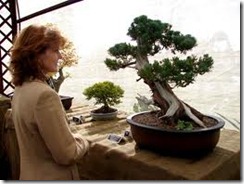 Overview
Overview
Bonsai first appeared in China approximately 1,000 years ago and is the practice of growing a single tree in a tray-type container. Bonsai developed an artistic component throughout Asia. Japan worked to create bonsai standards and regards its bonsai trees as a symbol of its ideals and culture.
History
A bonsai tree does not grow full size; the trunk becomes deformed and gnarled. These deformities many times resemble animals. The art of bonsai started spreading through Asia after Japan adopted the practice from China in the late 1100s. This is also the time that Zen Buddhism started. In the middle of the 19th century, Japan revealed its bonsai works of art, which went on exhibit throughout Europe.
Types
Any tree variety can be trained to form into a bonsai. Bonsai gardens are started with seeds, a cutting or small young trees that are naturally stunted in growth. The trees are kept small through pruning, pinching new growth, repotting and the use of wire to form the tree into shapes. In Japan the pine, bamboo, plum and azalea are common tree choices. Bonsai trees that are purchased are available in two types; temperate and tropical. Tropical trees do not tolerate freezing temperatures and must be protected when kept outside. Temperate bonsai go through a dormant period that varies from the tropical types. Bonsai trees should be kept outdoors for part of the year, as this provides the best environment for trees.
Planting a Bonsai
The soil used when planting a bonsai tree should include 30 percent grit and 70 percent humus for deciduous trees and 70 percent grit with 30 percent humus for evergreen or needle trees. Bonsai tree soil is available at retail gardening stores; however, mixing your own produces a better product. Marble sand and exploded clay are used for grit and peat moss, compost and pine bark are used for humus. Use sifting screens to eliminate pieces that are too large for growing. The pot size width should be two-thirds to three-fourths the height of the tree. For example, if a tree is 6 inches tall, then the pot should be approximately 3 inches wide and long. The depth of the pot should be approximately the same as the measurement of the tree trunk diameter.
Care and Maintenance
Bonsai trees will not live or grow properly without the correct amount of water. Each tree type requires varying amounts of water, and soil types dry out at different levels. Water early in the day and repeat three times to ensure that the tree, soil and pot have absorbed enough water. Once a week, submerge the pot in water to allow for a deep absorption. Gently wash the foliage to unclog tree breathing portals. Do not wash a flowering bonsai as this will cause the flowers to die early.
Bonsai Pruning Styles
There are five basic styles of bonsai. The slanting style is naturally occurring and works with most tree varieties. A formal upright tree grows upright under perfect and open conditions. Evergreen varieties work well with the formal upright style. The informal upright style has a trunk that bends as though it is bending with the wind. Conifer and ornamental trees work well with this style. The cascade style presents the growing point below the base of the pot, while the semi-cascade is the similar to the cascade, except the tip falls below the top edge of the pot.

Deprecated: strpos(): Passing null to parameter #1 ($haystack) of type string is deprecated in /home/agriviek8Qv/agriviet.net/public_html/wp-includes/comment-template.php on line 2522